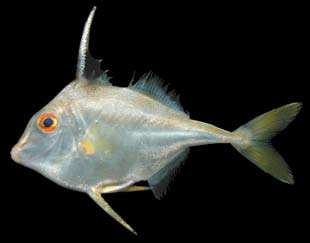TRIACANTHIDAE
Triplespines
By Keiichi Matsuura
 Triacanthus biaculeatus |
 Triacanthus nieuhofi |
|
Small fishes less than 30 cm, with moderately elongate, strongly compressed body covered by moderately thick skin with numerous minute scales. Mouth small and terminal; teeth in an outer series of about 10 heavy incisors in each jaw, internally to which are several molariform teeth, usually 4 in upper jaw and 2 in lower jaw. Gill opening a moderately short vertical slit in front of pectoral-fin base. Dorsal fin spine VI (usually only V visible, the sixth rudimentary), dorsal- fin rays 20 to 26; caudal fin deeply forked; pelvic fins with I large spine and no visible rays; most dorsal-, anal, and pectoral-fin rays branched. Caudal peduncle distinctly tapering to a narrow transversely indented region just in front of caudal-fin base, where the peduncle is wider than deep. Lateral line inconspicuous. Color: generally silvery, with upper half of body dusky, with or without darker blotches. Similar families occurring in the area. Triacanthodidae: caudal fin not deeply forked, rounded to almost truncate; caudal peduncle not distinctly tapered, deeper than wide; dorsal-fin rays 12 to 18 (20 to 26 in Triacanthidae). Remarks. Benthic, occurring usually on flat, sandy or weed-covered bottoms. Feed on bottom invertebrates. Marketed but not commercially important. |

|
|